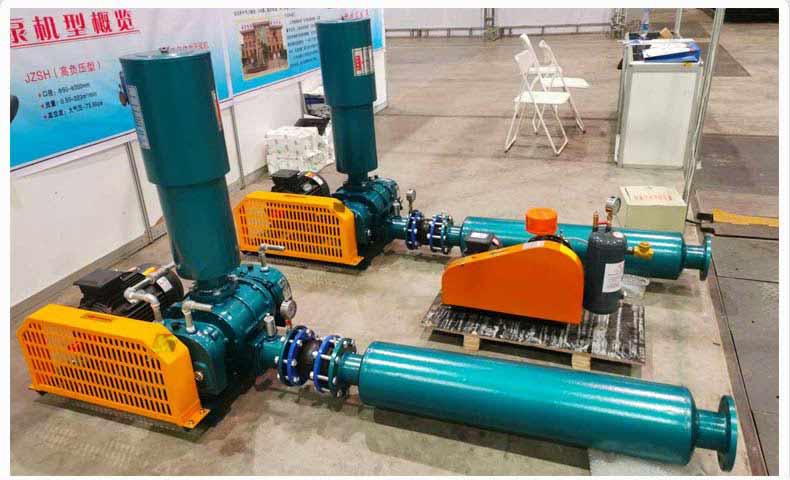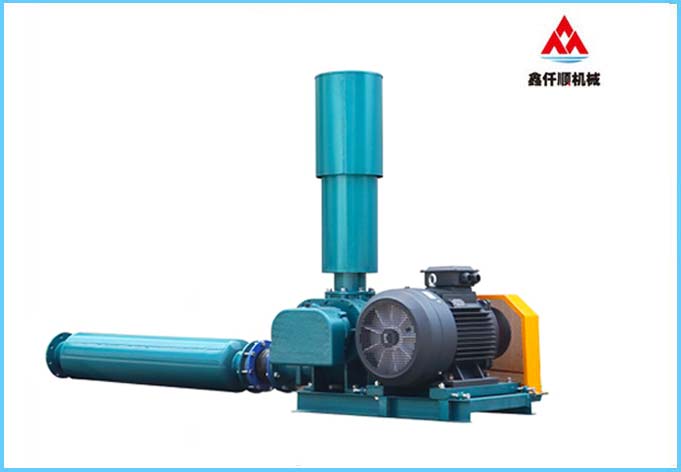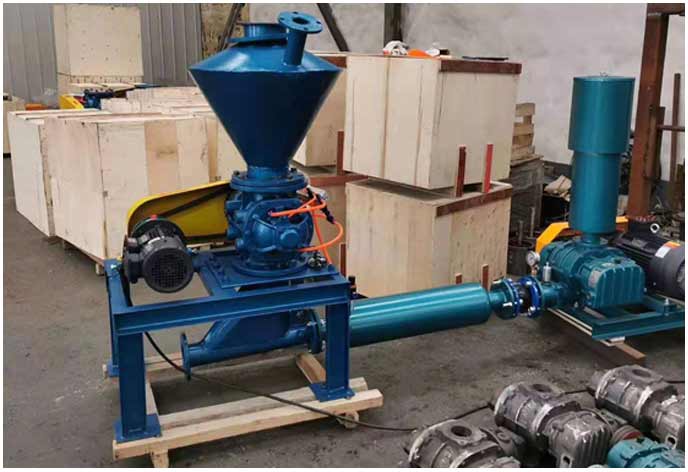Roots blower It is a kind of rotary blower. It is characterized by compact structure, high efficiency and energy saving, stable component, absolutely oil-free transmission medium, easy installation and maintenance, safe and reliable operation, etc. It is widely used in electric power, petroleum, chemical industry, smelting, cement, light industry, food, textile, pneumatic transmission, sewage treatment and other industries.
Working principle of Roots blower: Roots blower is mainly composed of body and two rotors with 8-shaped impeller. Through the action of a pair of synchronous gears, the two rotors rotate at a constant speed in the opposite direction, and the suction chamber and discharge chamber are basically isolated according to the clearance between the impeller and the impeller, and between the impeller and the engine body. With the rotation of the impeller, the two blade shaped rotors of the fan are used to make relative movement in the cylinder to compress and transport gas. The blower keeps the two rotors engaged by the synchronous gear at the rotor shaft end.
Each concave curved surface on the rotor forms a working volume with the inner wall of the cylinder. During the rotation of the rotor, the gas is taken away from the suction port. When the rotor moves to the moment when it is connected with the exhaust port near the exhaust port, the pressure in the working volume suddenly rises due to the backflow of high pressure gas, and then the gas is transported to the exhaust channel. The two rotors work alternately, The two rotors do not contact each other, and they are sealed by tightly controlled clearance. Therefore, the discharged gas will not be polluted by the lubricating oil to drive the gas in the body volume to achieve the purpose of air blowing. How to adjust and ensure that the clearance between the impeller and the rotor and the body reaches the specified range has become the focus of maintenance. Structure of Roots blower: the blower is mainly composed of impeller, main shaft, gear, sealing device, housing, base, etc. The fan has simple structure and is easy to manufacture. Technical parameters of JGR60 roots blower: Take R60x78 as an example, this blower is a blower in front of the furnace in the sulfuric acid plant. The impeller of this blower has a rotating diameter of 600mm, a length of 780mm, a motor of 220kw, a rotating speed of 960r/min, a pressure rise of 49.00kPa, and a flow of 199.3m3/min.
1、 Maintenance of main parts of fan

The impeller is made of cast iron and its working line is involute. Its irregular shape and high machining precision make it difficult to repair after damage. The damaged part of the main shaft of the fan usually occurs on the mating surface with the inner ring of the bearing. If it is worn 1~2mm, it can be repaired by electroplating. If it is worn deeply, it is better to replace the shaft with a new one. When replacing a new shaft, due to the tight fit (transitional fit) between the shaft and the impeller, and the long fitting surface, it is usually necessary to use a power driven hydraulic machine to press out the old shaft and press it into the new shaft. When pressing the shaft, it is difficult to control the installation size of only a few millimeters due to the power driven hydraulic equipment. For the above reasons, the main problem discussed in this paper is to select a convenient and cost saving maintenance method to achieve the purpose of continuous use of Roots blower. 2、 Working clearance
The static theoretical value of the clearance of all parts of Roots blower at normal temperature is: the clearance between impellers is 0.4mm~0.5mm; The radial clearance between impeller and casing is 0.2mm~0.3mm; The axial clearance between the impeller and the left and right wallboards is 0.3m~0.4mm; The mesh clearance of synchronous gear is 0.08mm~0.16mm. The adjustment of working clearance of roots blower is the most critical and difficult step in the whole maintenance process.
3、 Adjustment method
(1) Cleaning
1. Remove the inlet and outlet pipelines of roots blower, remove the acid sludge and sundries in roots blower, and seal the lower inlet with blind plate.
2. Remove from the upper part of roots blower and add 13% Na2CO3 aqueous solution until the rotating impeller does not overflow, and properly rotate the roots blower impeller to neutralize the acid in the fan. After 10~20 minutes, remove the lower blind plate to discharge the solution, and then repeatedly clean it twice according to this method. Finally, clean the roots blower with clean water.
3. Lift out the impeller in time, remove the dirt and sundries in the roots blower, two impellers and labyrinth seal, wipe the roots blower clean, and then wipe the wetted parts with antirust oil to prevent rust.
4. Lift the two impellers into the fan base and press the bearing boxes at both ends with two glands.
(2) Measurement
Adjust the two impellers to one side of the coupling at the same time with the adjusting screw to make the clearance between the two impeller end faces and the coupling side reach normal (about 0.4~0.5mm). Turn the two impellers and check whether the four sets of labyrinth seal components are in normal position. If not, record the size for proper processing or treatment when removing in the future.
Measure the clearance between the protruding parts of the two impellers and the arc surface of the base of Roots blower, measure the clearance between the protruding parts of the two impellers and the other impeller, measure the clearance between the end faces of the two impellers and the internal facades on both sides of the base, mark and record the above measurement positions.
Press the cover plate tightly, measure the gap between the convex position of the two impellers and the inner cambered surface of the cover plate, measure the gap between the two sides of the cover plate and the two sides of the two impellers, and mark and record them respectively.
(3) Repair
1. Studded strip
(1) 12 convex strips shall be processed according to the size. The material is determined according to the contact medium of Roots blower when it is used. If it contacts with acid, it is recommended to use acid resistant materials of certain strength, such as stainless steel. The following processing materials are the same.
(2) Mill dovetail grooves and drill holes at 4 convex positions of two impellers according to size.
(3) Machine 36 bolts and 36 matching nuts according to the size.
(4) Insert every three convex strips into four dovetail grooves of the impeller, and fasten them with bolts processed according to (3). If any part is too tight during installation, it can be polished with portable grinding wheel.
2. Inlaid end face
(1) Drill 12 bolt holes in the direction of two impellers near the gear according to the size.
(2) The end face inserts of two impellers in the direction of gear shall be processed according to the size, and a total of 4 pieces shall be processed (it is recommended that the inserts be inserted into the impellers and then drilled).
(3) Three kinds of fastening insert bolts shall be processed according to the size, 8 of each type, and 24 matching nuts shall be purchased or processed (nuts shall be processed according to common standards).
(4) Install the inserts into the end faces of the two impellers in the direction of the gear, and fasten them with the bolts processed according to (3).










